check engine Peugeot 3008 Hybrid 4 2014 User Guide
[x] Cancel search | Manufacturer: PEUGEOT, Model Year: 2014, Model line: 3008 Hybrid 4, Model: Peugeot 3008 Hybrid 4 2014Pages: 378, PDF Size: 22.5 MB
Page 108 of 378
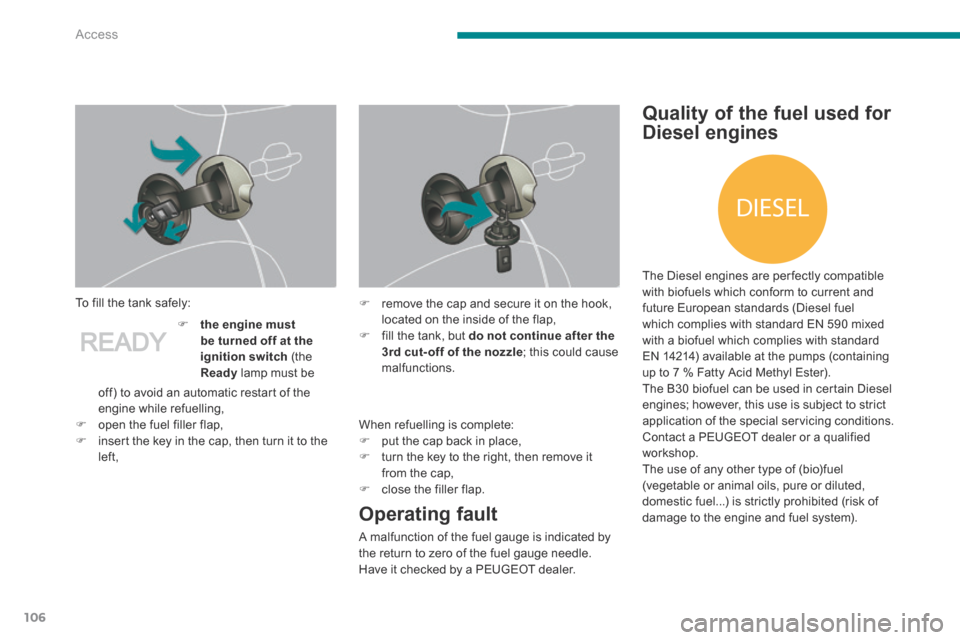
DIESEL
Access
106
To fill the tank safely:
When refuelling is complete: put the cap back in place, turn the key to the right, then remove it from the cap, close the filler flap.
Operating fault
A malfunction of the fuel gauge is indicated by the return to zero of the fuel gauge needle. Have it checked by a PEUGEOT dealer.
off) to avoid an automatic restart of the engine while refuelling, open the fuel filler flap, insert the key in the cap, then turn it to the left,
the engine must be turned off at the ignition switch (the Ready lamp must be
Quality of the fuel used for
Diesel engines
The Diesel engines are per fectly compatible with biofuels which conform to current and future European standards (Diesel fuel which complies with standard EN 590 mixed with a biofuel which complies with standard EN 14214) available at the pumps (containing up to 7 % Fatty Acid Methyl Ester). The B30 biofuel can be used in certain Diesel engines; however, this use is subject to strict application of the special servicing conditions. Contact a PEUGEOT dealer or a qualified workshop. The use of any other type of (bio)fuel (vegetable or animal oils, pure or diluted, domestic fuel...) is strictly prohibited (risk of damage to the engine and fuel system).
remove the cap and secure it on the hook, located on the inside of the flap, fill the tank, but do not continue after the 3rd cut- off of the nozzle ; this could cause malfunctions.
Page 109 of 378

4
Access107
Misfuel prevention (Diesel) *
Mechanical device which prevents filling the tank of a Diesel vehicle with petrol. It avoids the risk of engine damage that can result from filling with the wrong fuel. Located in the filler neck, the misfuel prevention device appears when the filler cap is removed.
Operation
* According to country of sale.
It remains possible to use a fuel can to
fill the tank. In order to ensure a good flow of fuel, do not place the nozzle of the fuel can in direct contact with the flap of the misfuel prevention device and pour s l ow l y.
When a petrol filler nozzle is introduced into the fuel filler neck of your Diesel vehicle, it comes
into contact with the flap. The system remains closed and prevents filling. Do not persist but introduce a Diesel type filler nozzle.
Travelling abroad
As Diesel fuel pump nozzles may be different in other countries, the presence of the misfuel prevention device may make refuelling impossible. Before travelling abroad, we recommend that you check with the PEUGEOT dealer network, whether your vehicle is suitable for the fuel pumps in the country in which you want to travel.
Page 158 of 378

Safety
156
Deactivation
In exceptional conditions (starting a vehicle which is bogged down, stuck in snow, on soft ground...), it may be advisable to deactivate the DSC system, so that the wheels can turn freely and regain grip.
Press the button.
This warning lamp and the indicator lamp in the button come on: the DSC system no longer acts on the operation of the internal combustion engine.
Reactivation
The system is reactivated automatically each time the ignition is switched back on or from 30 mph (50 km/h). Press the button again to reactivate it manually.
Operating fault
If this warning lamp comes on, accompanied by an audible signal and a message in the multifunction screen, this indicates a malfunction of the system. Contact a PEUGEOT dealer or a qualified workshop to have the system checked.
The DSC system offers exceptional safety in normal driving, but this should not encourage the driver to take extra risks or drive at high speed. The correct functioning of the system depends on observation of the manufacturer's recommendations regarding the wheels (tyres and rims), the braking components, the electronic components and the PEUGEOT assembly and operation procedures. After an impact, have the system checked by a PEUGEOT dealer or a qualified workshop.
Driving advice
Your vehicle is designed principally to drive on tarmac roads but it allows you to drive on other less passable terrain occasionally. However, it does not permit all-terrain activities such as: - crossing and driving on terrain which could damage the underbody or pull off components (fuel pipe, fuel cooler, high voltage cables, ...) due to obstacles or stones in particular, - crossing a stream.
Page 166 of 378
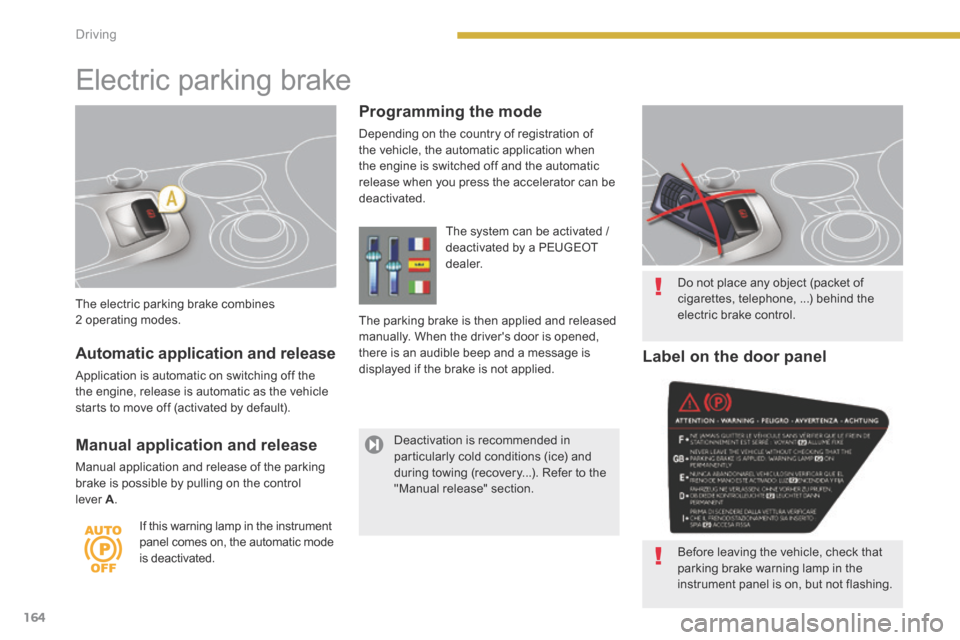
164Driving
The electric parking brake combines 2 operating modes.
Electric parking brake
Programming the mode
Depending on the country of registration of the vehicle, the automatic application when the engine is switched off and the automatic release when you press the accelerator can be deactivated.
If this warning lamp in the instrument panel comes on, the automatic mode is deactivated.
The system can be activated / deactivated by a PEUGEOT dealer.
The parking brake is then applied and released manually. When the driver's door is opened, there is an audible beep and a message is displayed if the brake is not applied. Automatic application and release
Application is automatic on switching off the the engine, release is automatic as the vehicle starts to move off (activated by default).
Manual application and release
Manual application and release of the parking brake is possible by pulling on the control lever A .
Label on the door panel
Do not place any object (packet of cigarettes, telephone, ...) behind the electric brake control.
Deactivation is recommended in particularly cold conditions (ice) and during towing (recovery...). Refer to the "Manual release" section.
Before leaving the vehicle, check that parking brake warning lamp in the instrument panel is on, but not flashing.
Page 168 of 378
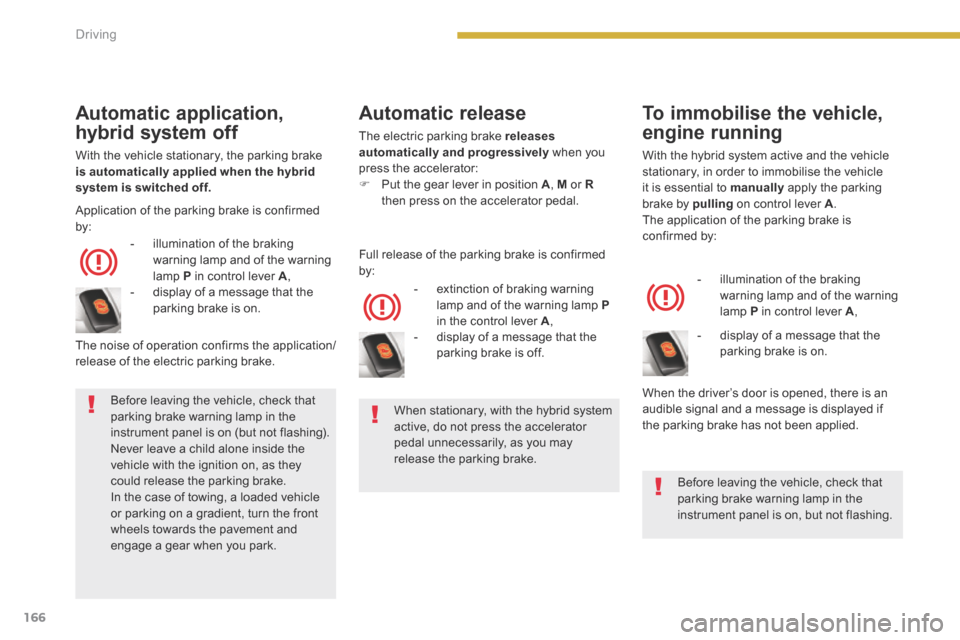
166Driving
Automatic application,
hybrid system off
With the vehicle stationary, the parking brake is automatically applied when the hybrid system is switched off.
- illumination of the braking warning lamp and of the warning lamp P in control lever A ,
Automatic release
The electric parking brake releases automatically and progressively when you press the accelerator: Put the gear lever in position A , M or Rthen press on the accelerator pedal.
- extinction of braking warning lamp and of the warning lamp Pin the control lever A ,
The noise of operation confirms the application/ release of the electric parking brake.
Full release of the parking brake is confirmed by:
To immobilise the vehicle,
engine running
With the hybrid system active and the vehicle stationary, in order to immobilise the vehicle it is essential to manually apply the parking brake by pulling on control lever A . The application of the parking brake is confirmed by:
- illumination of the braking warning lamp and of the warning lamp P in control lever A ,
When the driver’s door is opened, there is an audible signal and a message is displayed if the parking brake has not been applied.
Application of the parking brake is confirmed
by:
- display of a message that the parking brake is on.
- display of a message that the parking brake is off.
- display of a message that the parking brake is on.
Before leaving the vehicle, check that parking brake warning lamp in the instrument panel is on (but not flashing). Never leave a child alone inside the vehicle with the ignition on, as they could release the parking brake. In the case of towing, a loaded vehicle or parking on a gradient, turn the front wheels towards the pavement and engage a gear when you park.
When stationary, with the hybrid system active, do not press the accelerator pedal unnecessarily, as you may release the parking brake.
Before leaving the vehicle, check that parking brake warning lamp in the instrument panel is on, but not flashing.
Page 184 of 378
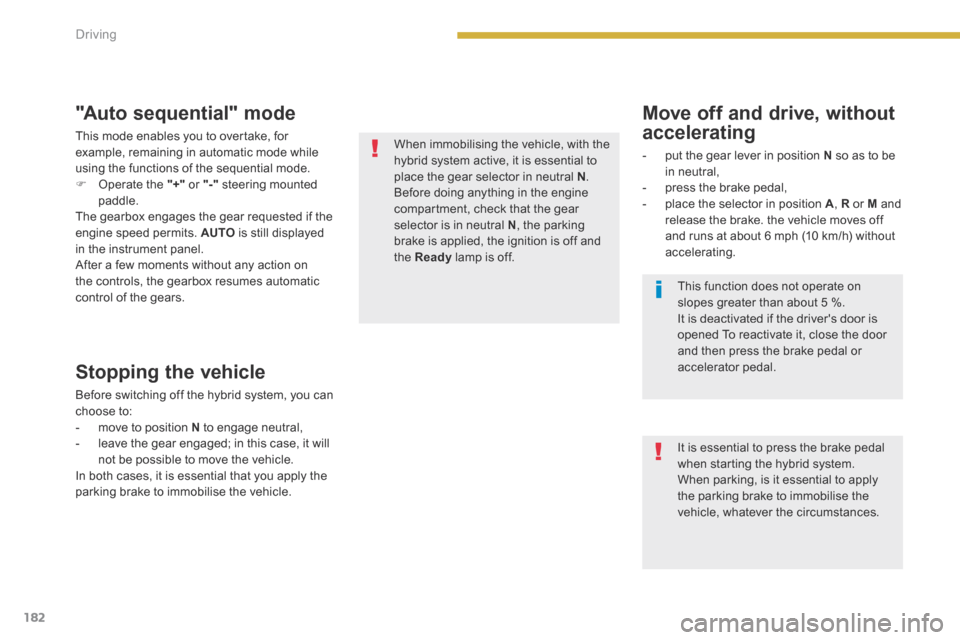
182Driving
Stopping the vehicle
Before switching off the hybrid system, you can choose to: - move to position N to engage neutral, - leave the gear engaged; in this case, it will not be possible to move the vehicle.
In both cases, it is essential that you apply the parking brake to immobilise the vehicle.
"Auto sequential" mode
This mode enables you to overtake, for example, remaining in automatic mode while using the functions of the sequential mode. Operate the "+" or "-" steering mounted paddle. The gearbox engages the gear requested if the engine speed permits. AUTO is still displayed in the instrument panel. After a few moments without any action on the controls, the gearbox resumes automatic control of the gears.
When immobilising the vehicle, with the hybrid system active, it is essential to place the gear selector in neutral N . Before doing anything in the engine compartment, check that the gear selector is in neutral N , the parking brake is applied, the ignition is off and the Ready lamp is off.
Move off and drive, without
accelerating
- put the gear lever in position N so as to be in neutral, - press the brake pedal, - place the selector in position A , R or M and release the brake. the vehicle moves off
and runs at about 6 mph (10 km/h) without accelerating.
It is essential to press the brake pedal when starting the hybrid system. When parking, is it essential to apply the parking brake to immobilise the vehicle, whatever the circumstances.
This function does not operate on slopes greater than about 5 %. It is deactivated if the driver's door is opened To reactivate it, close the door and then press the brake pedal or accelerator pedal.
Page 190 of 378
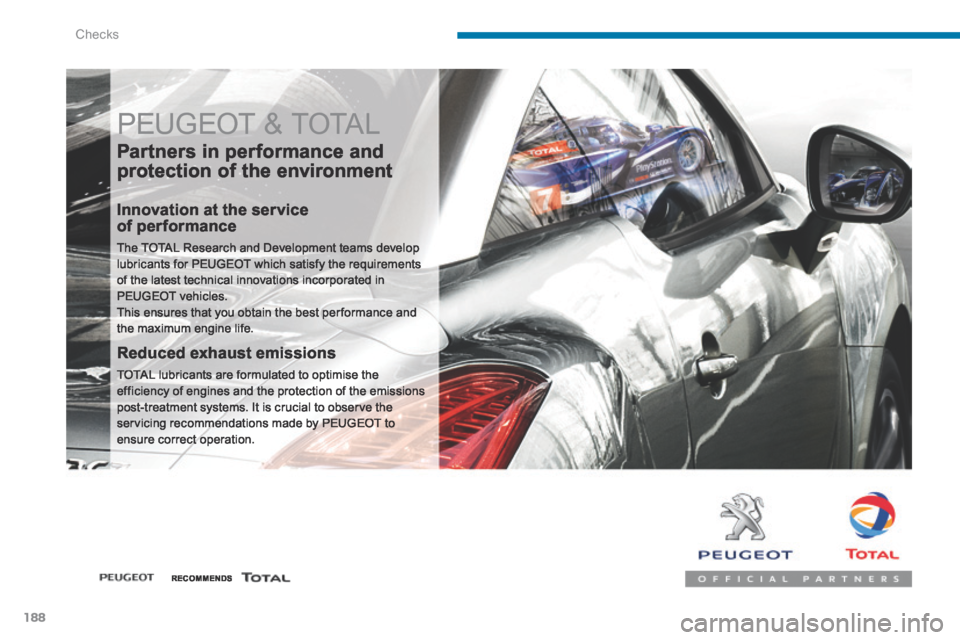
Checks
188
PEUGEOT & TOTAL
Partners in performance and
protection of the environment
Innovation at the service of performance
The TOTAL Research and Development teams develop lubricants for PEUGEOT which satisfy the requirements of the latest technical innovations incorporated in PEUGEOT vehicles. This ensures that you obtain the best per formance and the maximum engine life.
Reduced exhaust emissions
TOTAL lubricants are formulated to optimise the efficiency of engines and the protection of the emissions post-treatment systems. It is crucial to observe the servicing recommendations made by PEUGEOT to ensure correct operation.
RECOMMENDSRECOMMENDS
Page 191 of 378
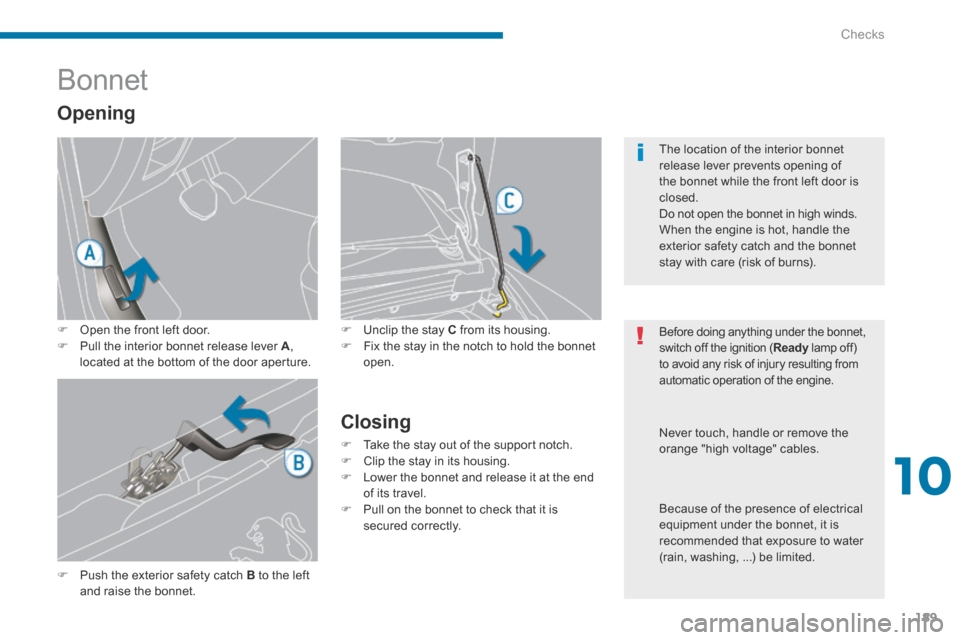
10
Checks189
Bonnet
Unclip the stay C from its housing. Fix the stay in the notch to hold the bonnet open.
Closing
Take the stay out of the support notch. Clip the stay in its housing. Lower the bonnet and release it at the end of its travel. Pull on the bonnet to check that it is secured correctly.
Opening
Open the front left door. Pull the interior bonnet release lever A , located at the bottom of the door aperture.
Before doing anything under the bonnet, switch off the ignition ( Ready lamp off) Ready lamp off) Readyto avoid any risk of injury resulting from automatic operation of the engine.
The location of the interior bonnet release lever prevents opening of the bonnet while the front left door is closed. Do not open the bonnet in high winds.
When the engine is hot, handle the exterior safety catch and the bonnet stay with care (risk of burns).
Push the exterior safety catch B to the left and raise the bonnet.
Never touch, handle or remove the orange "high voltage" cables.
Because of the presence of electrical equipment under the bonnet, it is
recommended that exposure to water (rain, washing, ...) be limited.
Page 192 of 378

Checks
190
Running out of fuel (Diesel)
2 litre HDi engine
Fill the fuel tank with at least five litres of Diesel. Open the bonnet. If necessary, unclip the style cover for access to the priming pump. Slacken the bleed screw. Squeeze and release the priming pump repeatedly until fuel appears in the transparent pipe. Tighten the bleed screw. Operate the starter until the engine starts (if the engine fails to start at the first attempt, wait around 15 seconds before trying again). If the engine fails to start after a few attempts, operate the priming pump again, then the starter. Put the style cover back in position and clip it in place, ensuring that it has clipped
c o r r e c t l y. Close the bonnet.
On vehicle fitted with HDi engines, the fuel system must be primed if you run out of fuel; refer to the corresponding engine compartment view.
If the tank on your vehicle is fitted with a
misfuel prevention device, refer to the "Misfuel prevention (Diesel)" section.
Before doing anything under the bonnet, switch off the ignition ( Readylamp off) to avoid any risk of injury resulting from automatic operation of the engine.
If the engine does not start first time, don't keep trying but start the procedure again from the beginning.
Page 193 of 378
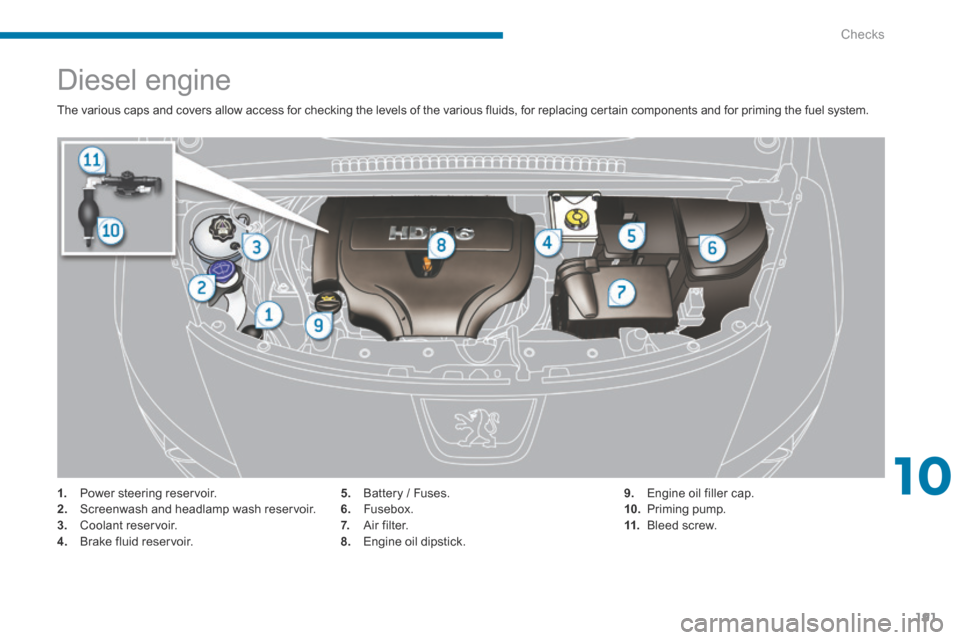
10
Checks191
Diesel engine
The various caps and covers allow access for checking the levels of the various fluids, for replacing certain components and for priming the fuel system.
1. Power steering reservoir. 2. Screenwash and headlamp wash reservoir. 3. Coolant reservoir.
4. Brake fluid reservoir.
5. Battery / Fuses. 6. Fusebox. 7. Air filter.
8. Engine oil dipstick.
9. Engine oil filler cap. 10. Priming pump. 11. Bleed screw.